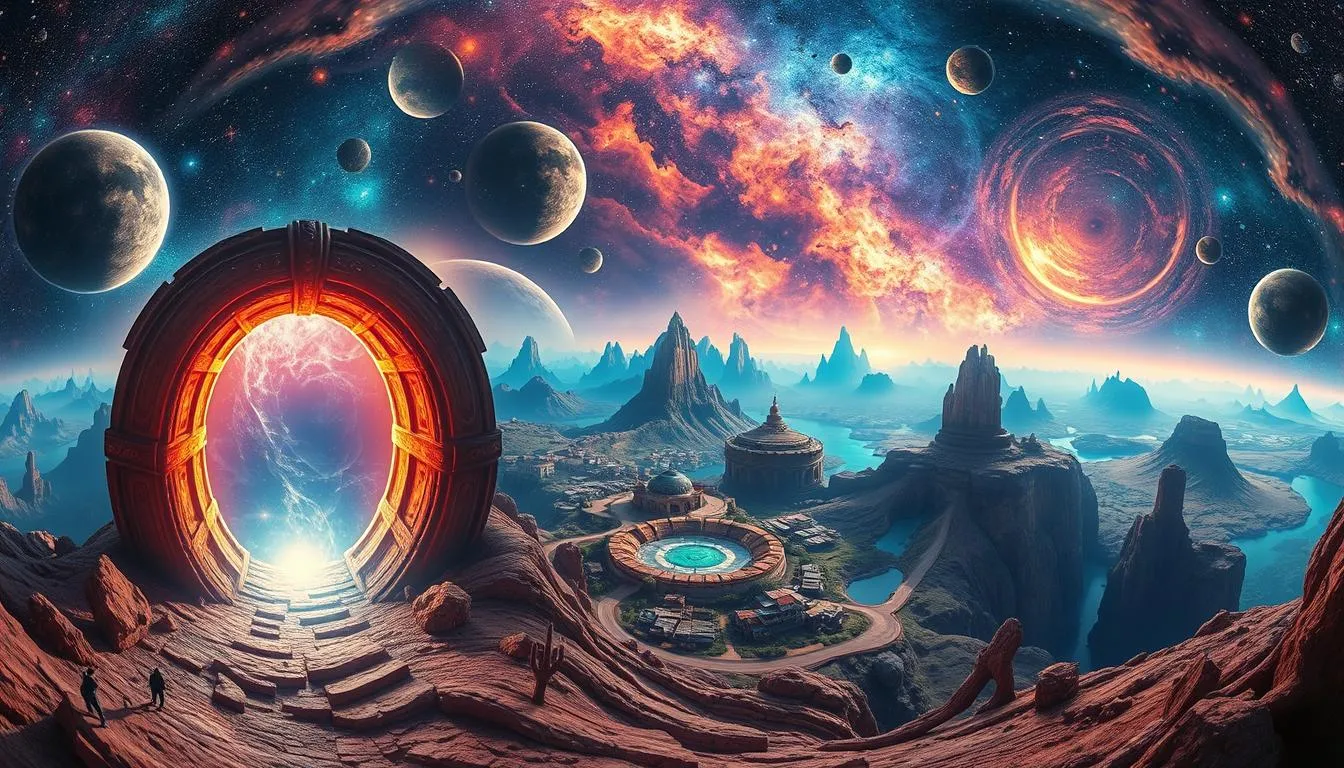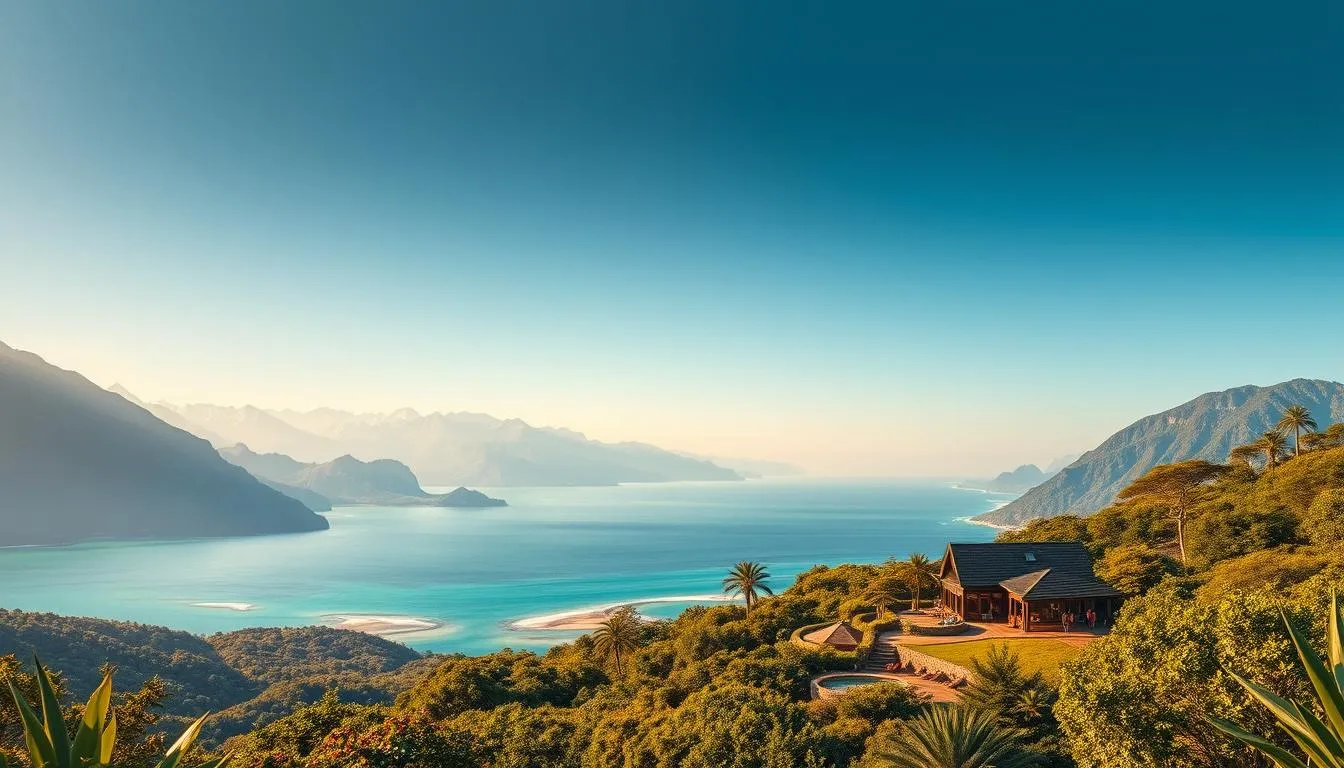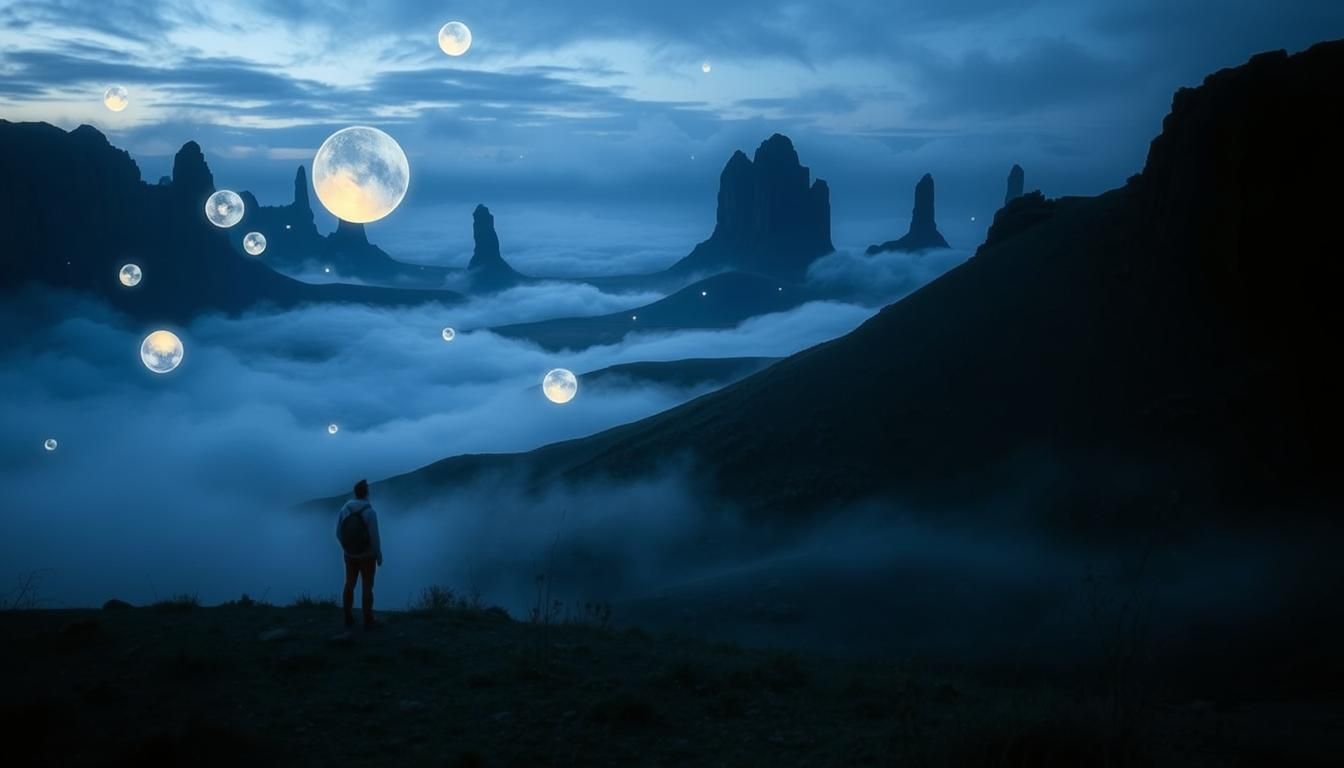Did you know that a single moment of awe—like viewing the Aurora—can lower stress and boost thinking for days? This guide helps U.S. travelers find those moments around the world with clear, friendly advice.
This short guide defines the big idea: a curiosity-led way to chase rare natural sights, from glowing caves to mirror-like salt flats. Backed by research, time in nature often lifts mood and sharpens cognition. We blend science with practical tips so your trip is inspiring and smart.
Use the list to scan destinations, best seasons, and safety notes. We cover a wide range of scenes—lit skies, pink seas, thundering falls—and pair inspiration with facts, local nuance, and sustainable behavior. Social media may spark the find, but we urge mindful choices over crowd chasing as this trend sees a steady rise.
Key Takeaways
- A single awe-filled event can improve mood and thinking.
- This guide mixes science, safety, and planning tips.
- Find where to go, when to visit, and what to pack.
- Features range from skies and seas to reflective flats.
- Choose mindful visiting to protect fragile places.
What Is Phenomena Tourism and Why It Captivates Us
Travel driven by rare natural events asks us to slow down and watch the world change. This kind of trip is about seeking rare sights—from glowing caves to skies that come alive with light.
Awe, nature, and the human psyche: how extraordinary events shape experience
Studies show time outdoors boosts mood, lowers stress, and can sharpen thinking. Those benefits set the stage for deeper memories when you witness a dramatic display.
Awe is a distinct feeling. Big, colorful skies or broad, empty space can shrink self-focus and widen perspective. People often call that moment transformative.
The Aurora illustrates how light, color, and vast space combine to move us. The Southern Lights, for example, glow in greens, purples, blues, and reds and peak in the Southern Hemisphere winter near the September equinox.
- Why it matters: change—seasonal cycles and shifting weather—adds meaning and anticipation.
- Traveler mindset: patience, flexibility, and curiosity pay off more than rigid plans.
- Outcome: trips focused on presence yield richer experience than stamp-collecting itineraries.
| Emotional Effect | Best Timing | Traveler Tip |
|---|---|---|
| Elevated mood and calm | Seasonal peaks (e.g., winter auroras) | Plan windows, not fixed dates |
| Awe and perspective shift | Short, predictable windows (equinox, blooms) | Bring layers and patience |
| Memory-rich experience | Variable weather periods | Hire a local guide for context |
Bucket-List Destinations and Events for Phenomena Tourism
From electric storms to mirror-flat salt pans, these destinations serve up nature’s most dramatic acts. Below are practical notes on when to go, what to expect, and how to see each site responsibly.

Aurora Australis in Tasmania
Best months: May–August, with a boost near the September equinox. Head to Bruny or Satellite Islands for clear horizons and higher odds of seeing the Southern Lights.
Catatumbo Lightning, Venezuela
Nearly 300 nights a year, storms light the sky by Lake Maracaibo. Warm Caribbean air meeting Andean currents fuels long displays; guided boat tours offer safe, close viewing.
Waitomo Glowworm Caves, New Zealand
Bioluminescent larvae turn cave ceilings into starry chandeliers. Short boat rides keep visits quiet—use low-light camera settings and follow guide rules to protect the ecosystem.
Salar de Uyuni, Bolivia
When rains fill the salt crust, the plains become the world’s largest mirror. Aim for December–April, but watch that heavy December–January storms can force cancellations.
- Compare: Iguazu and Victoria Falls offer thunderous scale and, at full moon, rare lunar rainbows.
- Season windows: Iceberg Alley runs late April–early June; Ha Long Bay is ideal for overnight cruises and cave stops.
- Plan flexibly to link nearby sites and use local weather to time sightings.
- Practice low-impact behavior so these events and sites remain inspiring for future visitors and support sustainable tourism.
For more ideas on natural wonders, see this guide to natural phenomena worth a trip.
The Rise of Phenomena Tourism in a Changing World
Digital feeds and cheaper flights have rewritten how we find and reach rare natural sights. The mix of social platforms, low-cost carriers, and the sharing economy makes discovery fast and travel planning flexible.

Social media and experiential travel fueling discovery and demand
Social media showcases spectacular places in real time and nudges travelers to value experiences over things.
Creators highlight peak moments and practical tips. That visibility spurs quick interest and sudden visitor surges, which can overwhelm local services.
Low-cost flights and the sharing economy reshaping access to remote sites
Low fares and peer-to-peer lodging have opened routes that once needed complex logistics. Remote viewing spots are now within reach for more people.
This access brings choices—and responsibility. The tourism industry must balance demand with local limits, while communities set rules to protect places.
| Driver | Effect | Traveler tactic |
|---|---|---|
| Social media | Rapid discovery; short attention spikes | Follow local accounts; learn etiquette |
| Low-cost carriers | More routes; fragile sites easier to reach | Book flexible fares; plan backup routes |
| Sharing economy | Alternative lodging and transport options | Choose hosts who support off-peak visits |
The last few years of global change—health crises, geopolitical shocks, and extreme weather—have shifted demand and risk perceptions. That means timing and spacing trips matters more than ever.
Creators and local groups can channel media interest into good behavior: promote off-peak visits, share quieter viewpoints, and teach less intrusive viewing habits. Travelers should use flexible bookings and consider local transport to navigate volatility without losing the core experience.
Next: we link these shifts to sustainability and practical planning so your visits stay safe, respectful, and memorable.
Sustainability, Policy, and the Tourism Industry’s Impact
Sustainable planning turns short-lived visitor spikes into long-term wins for nature and small communities. Research shows that unmanaged crowds can quickly harm fragile ecosystems and local services. The impact is often visible in eroded trails, light pollution, and stressed wildlife.
 Simple policy tools—permits, timed entries, and guided routes—help spread visits and reduce pressure. Heritage and pilgrimage sites use these fixes well; nature-focused destinations can adapt them. Clear rules make visits fairer and safer for locals and guests.
Simple policy tools—permits, timed entries, and guided routes—help spread visits and reduce pressure. Heritage and pilgrimage sites use these fixes well; nature-focused destinations can adapt them. Clear rules make visits fairer and safer for locals and guests.
Operators and the wider industry that invest in environmental management usually improve both conservation and visitor satisfaction. Destinations with visible sustainability practices tend to earn higher ratings and repeat visits, so responsible choices benefit everyone.
- Use real-time data and geoinformatics to inform closures and capacity limits.
- Choose sharing-economy hosts and guides who support local stewardship.
- Stick to marked paths, cut noise and light at night, and respect cultural norms.
To vet providers, look for transparent conservation fees, public reporting, and credentials tied to sustainable development. Small actions by travelers add up and help keep remarkable places healthy for future visitors.
Space and Time Matter: When and Where Phenomena Peak
Good planning treats space and time as partners: where you stand and when you go decide what you will see.
Seasonality signals: winter skies, spring thaws, and equinox alignments
Season windows set the stage. Winter brings the clearest auroral displays; spring thaws free ice and send bergs drifting.
Plan by month: aim May–August for the Aurora Australis and near the September equinox for extra activity. Head to Iceberg Alley in late April–early June. For Salar de Uyuni’s mirror, target December–April but note heavy December–January rains can cancel tours.
Night vs. day: light, moonbows, and the magic of dark-sky destinations
Day and night offer different rewards. Full-moon nights can create moonbows at Victoria Falls, while the darkest skies reveal the brightest auroras.
“Build buffer days and an alternate site into your plan—weather is the variable you cannot book around.”
Latitude, altitude, and local geography change what you see. Higher altitude and clear horizons improve aurora and sky viewing. Coastal bays, valleys, and plains change fog and reflection patterns.
- Choose a destination window by balancing crowd levels, weather stability, and local events.
- Be flexible: add buffer days, keep nearby alternatives, and watch forecasts.
- Use tools—moon phase calendars, aurora forecasts, and iceberg trackers—to time outings across the world.
Respect night-sky etiquette: dim lights and cut noise to protect wildlife and keep the scene for everyone.
Planning Your Trip: Responsible, Safe, and Smart
Good plans start before you pack: safety, flexibility, and local rules shape successful trips.
Essential gear and prep for extreme weather and remote places
Pack layers for cold and wet conditions. Bring waterproof boots, dry bags, and spare batteries.
Carry a headlamp with a red-light mode and a tripod for low-light photos. Offline maps and a charged power bank matter in low-signal areas.
Travel insurance, safety, and local guides at phenomena-rich sites
Insurance can cover medical emergencies abroad and some non-refundable costs if weather forces cancellations. Domestic health plans may not protect you overseas.
Book reputable local guides for complex sites — boat tours for Catatumbo Lightning, certified cave guides, or ice-aware teams near icebergs. Guides improve safety and the overall experience.
Leave no trace: responsible travel and destination stewardship
Build buffer days, pre-identify alternatives, and set cancellation alerts for places like Salar de Uyuni during heavy rain months.
Check river levels and weather, obey closures, and use iceberg trackers and shore-based tools when applicable. Pack out trash, stay on marked paths, and cut night lighting.
- Choose operators that publish safety policy and limit group size.
- Share accurate condition reports to community forums to help other travelers and protect fragile sites.
- Plan for delays—flexibility reduces stress and improves the trip’s overall effect.
From Studies to Real-World Practice: Research Shaping Phenomena Tourism
Scholars are mapping how mobility, media, and policy interact to shape visits to rare sights. This work helps managers turn evidence into on-the-ground rules that protect places and keep visits rewarding.
Sustainable development, mobility, and managing overtourism
Research shows that linking conservation with visitor experience improves both protection and satisfaction. Studies in sustainability note that perceived sustainable development boosts repeat visits and local support.
Digitalization, social media, and low-cost flights change where and when people travel. The tourism industry can use mobility data, capacity thresholds, and sentiment tracking to ease crowding without blocking access.
Practical takeaways:
- Use timed entries and guided-night policies to spread visits across hours and days.
- Promote off-peak itineraries and lesser-known sites to disperse demand.
- Encourage traveler reporting and citizen science to feed adaptive management systems.
| Research insight | Manager action | Traveler tip |
|---|---|---|
| Space–time mobility models | Design season/day shifts and buffer windows | Book flexible dates and add buffer days |
| Social media amplification | Promote off-peak routes and local viewpoints | Follow official local accounts for etiquette |
| Sustainable development links to satisfaction | Publish conservation fees and capacity rules | Choose operators with transparent sustainability policy |
| Anthropocene syntheses (Springer Nature) | Build resilience plans and real-time alerts | Join citizen science projects and report observations |
Work from Springer Nature and related publications synthesizes lessons from global change and offers tools to future-proof destinations. For an example of research linking public health and mobility, see this study on adaptive responses: adaptive health and mobility research.
Conclusion
Smart choices before and during your trip turn uncertainty into a richer experience. With clear plans—pick the right month, hire a local guide, and build buffer days—you raise the odds of seeing the show and keep stress low.
Expect real-world challenges: volatile weather, capacity limits, and changing rules. Stay flexible and you reduce the negative effect of disruptions and turn delays into new chances to explore nearby spots or learn from hosts.
The long-term impact ties to development, local industry, and the wider economy. Low-impact gear, quiet night viewing, and respectful behavior help destinations stay healthy. Keep learning from research and destination advisories.
Ready to go? Pick one destination, finish your plans, and set a date—go see the world this year and witness why these moments matter.
FAQ
What is phenomena tourism and why does it attract travelers?
Phenomena tourism is travel motivated by rare natural events and striking places, like auroras, bioluminescent caves, or mirror-like salt flats. People seek these moments for awe, unique photos, and the emotional impact of standing before something extraordinary. Social media and experiential travel trends have amplified interest, turning once-remote sites into must-see destinations.
When are the best times to visit sites like the Aurora Australis or Salar de Uyuni?
Timing depends on the event. Southern Lights peak in winter months when nights are longest and skies are dark. Salar de Uyuni’s legendary mirror effect happens in the rainy season when a thin sheet of water covers the salt crust. Check local seasonality guides and moon phases; light conditions and weather patterns determine the quality of the experience.
How can travelers reduce their impact on fragile sites such as glowworm caves or pink lakes?
Choose certified local guides, follow established trails, and avoid touching delicate formations or stirring sediments. Support operators that limit group sizes and contribute to conservation fees. Simple actions — pack out waste, use reef-safe sunscreen near sensitive waters, and respect restricted zones — protect ecosystems and sustain livelihoods.
Are there safety considerations for visiting remote phenomenon sites like Iceberg Alley or Catatumbo Lightning?
Yes. Remote locations often mean harsh weather, limited medical access, and shifting conditions. Bring appropriate gear, check insurance for emergency evacuation, and work with experienced operators who monitor hazards. Local knowledge reduces risk from cold seas, sudden storms, or challenging terrain.
How has social media changed how people find and visit these destinations?
Platforms like Instagram and TikTok have sped discovery and increased demand for picture-perfect spots. That rise in attention can bring economic benefits but also pressure on infrastructure and the environment. Responsible sharing — including mentioning guides, rules, and best times to visit — helps protect the place and supports sustainable development.
Can visiting phenomena sites benefit local economies and communities?
Yes — when managed well. Tourism can fund conservation, create jobs for guides, hospitality staff, and transport providers, and encourage cultural exchanges. Policy and planning are critical: local authorities and businesses must balance access with preservation to avoid overtourism and protect long-term economic resilience.
What gear should I pack for stargazing, aurora hunting, or cave visits?
Essentials include layered clothing for cold nights, a sturdy tripod for low-light photography, headlamp with red light to preserve night vision, and waterproof boots for wet or icy ground. For caves, wear a helmet if required and follow guide instructions. Pack minimal, high-quality gear to reduce weight and waste.
How do researchers and planners help manage visitor pressure at popular phenomenon sites?
Academics and planners study visitor flows, seasonal peaks, and ecological thresholds to inform policy. Strategies include timed entry, visitor caps, zoning, and infrastructure upgrades that direct foot traffic. Collaboration among universities, local governments, and tourism operators supports evidence-based solutions.
Is it worth visiting lesser-known alternatives to crowded sites like Iguazu or Ha Long Bay?
Absolutely. Lesser-known sites often offer equally powerful experiences with fewer crowds and lower environmental strain. Choosing alternative destinations spreads economic benefits and reduces pressure on iconic spots. Local operators can recommend hidden gems that match your interests and respect conservation goals.
How can I plan a trip that balances experience with sustainability and safety?
Start by researching seasons and local rules, book through certified guides, and prioritize accommodations and operators with clear sustainability policies. Buy travel insurance that covers remote-evacuation if needed, respect local customs, and leave no trace. Thoughtful planning ensures memorable experiences while protecting places for future visitors.
